![]()
![]()
![]()
Use LEFT and RIGHT arrow keys to navigate between flashcards;
Use UP and DOWN arrow keys to flip the card;
H to show hint;
A reads text to speech;
16 Cards in this Set
- Front
- Back
- 3rd side (hint)
|
VCM experiments allowed for four different conclusions about ion channels |
1) allow for large amounts of ion passage 2) can select for specific ions 3) are voltage dependent 4) use electric gradients to their advantage |
|
|
|
Pcm methods and their uses |
1) whole cell: allows for injection of materials into the cell 2) inside out; allows testing of internal cell membrane 3) outside in; allows testing of external membrane e.g. neurotransmitters 4) one channel; allows measurement of a single ion channel |
|
|
|
K+ ion channel current |
1-2 pA |
|
|
|
Draw graphs of A) Average microscopic Ix B) Average macroscopic Ix C) Probability frequency table for channels opening for x When membrane potential is stimulated to 50 mV and -20mV respectively for Na+ and K+ ion channels on a giant squid axon |

|
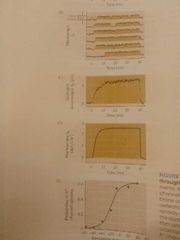
|
|
|
General principles of composite K+ ion channels |
Consists of a tetrad of subunits
Subunit >Internal (-)and external helix >pore loop with subcomponent >Voltage sensor (trans membrane) ->Helical linker to block the pore >T1 linking unit -> B subunit
Works by allowing only K+ ions to pass outward. Multiple forces affect this process: 1) Negative internal helices (due to carbonyl groups) have subunits that dehydrate ions precisely enough to only allow potassium to enter 2) K+ ions repel each other toward the exit (4 at a time in channel) |
|
|
|
How many ion channel genes |
Over 200 |
|
|
|
Na+ Channels |
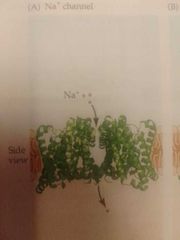
-10 SCN genes -Multiple variations, some f.e. don't inactivate completely -6 times membrane spanning sub units in a tetrad; 4 of the helices for voltage sensor -Pore is the ion filter, formed by pore loops |
|
|
|
Ca2+ channels |
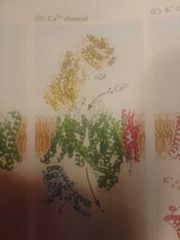
-6 times membrane spanning regions in a tetrad; pore loops, voltage sensors -Regulate neurotransmitter release; prolong action potential -10 CACNA genes thus far identified |
|
|
|
K+ Channels |
-Most diverse ion channel class -almost 100 KCN genes known Insane amounts of diversity -Inward rectifier channels respond to hyperpilarization -2-P channels respond to PH levels -Calcium activated channels respond to calcium |
|
|
|
Cl- Channels |
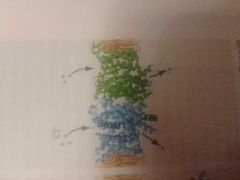
-CLCN genes control expression -Teo subunits, spanning many times; two pores -No voltage sensor; movement of a pore amino acid affects permeability |
|
|
|
Ligand gated ion channels |
-May accept a variety of ligands such as Ca2+, secondary intracellular messangers, neurotransmitters, pH etc. -generally less selective than VGIC:s -present in organelles as well as cell membranes |
|
|
|
TRP family; TRPV1 |
Detects heat based on, for example, temperature-based displacement of membrane lipids. TRPV1 detects both heat but is also a ligand based protein channel with capsaisin as a functioning ligand. |
|
|
|
Mechanosensitive ion channels |
At some absurd point actually utilize levers to open the channel |
|
|
|
ATPase pumps |
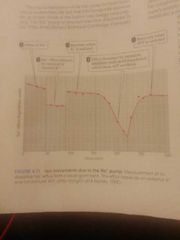
Found by understanding that ATP inhibitance via toxins reduces Na+ or K+ influx/efflux. Thus pumps require both ions to function, and further are related to sustaining concentration gradients that are destroyed upon firing an AP. |
|
|
|
Structures of Na/K and Ca2+ pumps |

|
|
|
|
Antiporter vs co-transporter |
Same charge different direction, different charge same direction |
|

